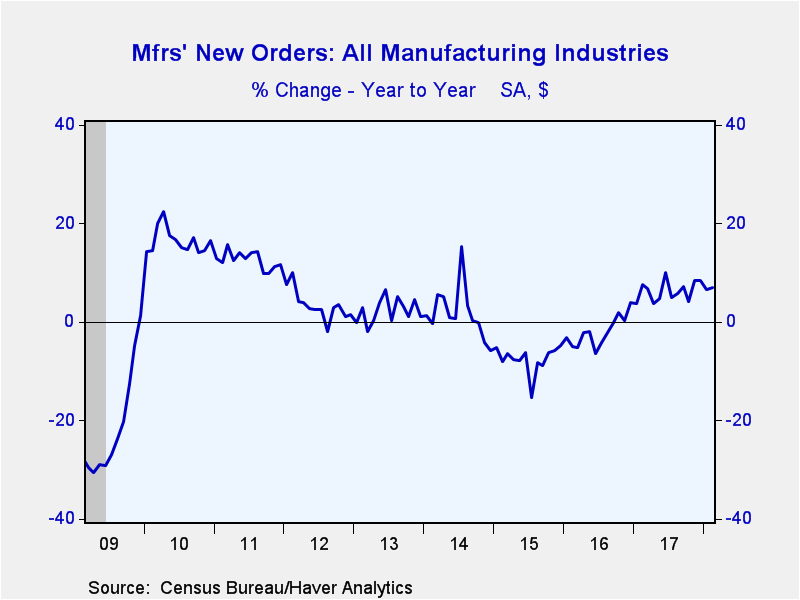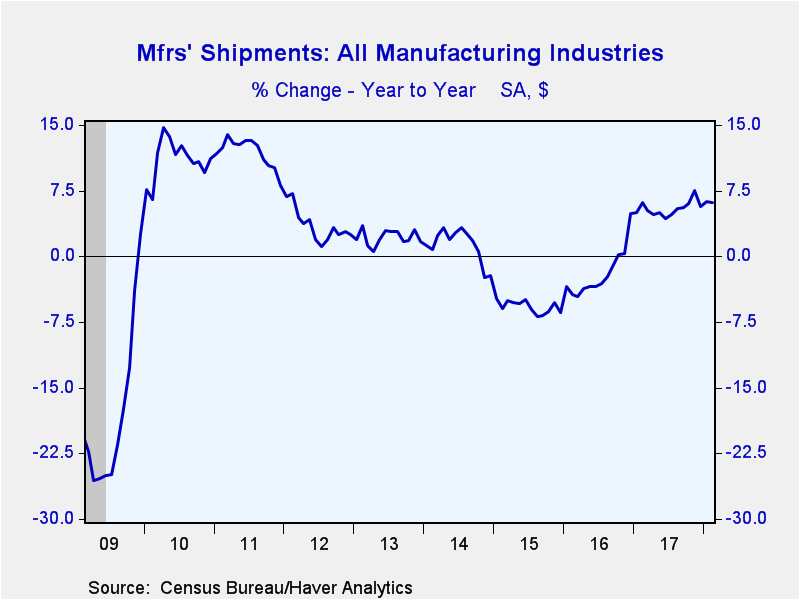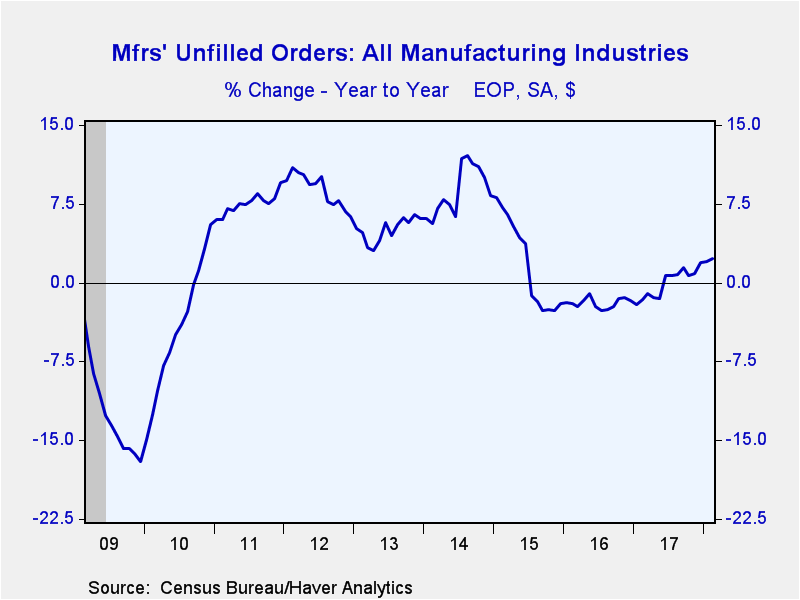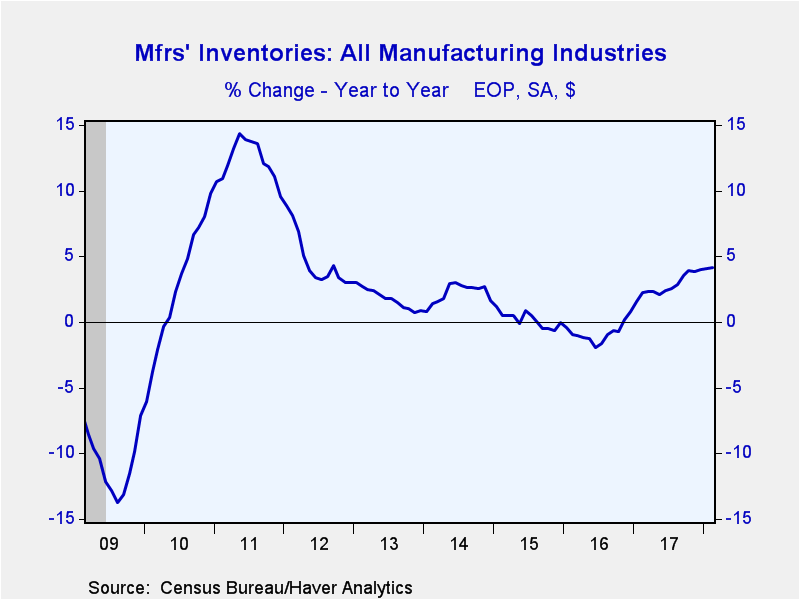 Global| Apr 04 2018
Global| Apr 04 2018U.S. Factory Orders Rebound; Shipments Hit a Record High
Summary
Manufacturers' orders rebounded 1.2% (+7.1% year-on-year) during February following a 1.3% decline in January. Manufacturing shipments increased 0.2% (+6.1% y/y) to a record high $501 billion. Shipments have risen for 11 consecutive [...]
Manufacturers' orders rebounded 1.2% (+7.1% year-on-year) during February following a 1.3% decline in January. Manufacturing shipments increased 0.2% (+6.1% y/y) to a record high $501 billion. Shipments have risen for 11 consecutive months.
Orders in the volatile durable goods sector jumped 3.0% (+8.7% y/y), following a 3.6% drop in January. Orders for transportation equipment soared 7.0% (+10.6% y/y) due to a 26.2% surge in civilian aircraft bookings. These increases follow large declines in orders in January and leave the level of both transportation and civilian aircraft orders below their December 2017 levels. Total factory orders excluding transportation edged up 0.1% (6.4% y/y), the weakest monthly rise since June 2017. Machinery orders increased 1.2% (+8.8% y/y) after a -0.2% decline. Orders for computers & electronic products edged down 0.1% (+6.6% y/y), the second consecutive deterioration.
Shipments of durable goods rose 0.9% (6.8% y/y) to a record high $250 billion. Shipments of transportation product increased 0.5% (5.4% y/y) reflecting a 0.9% gain in civilian aircraft & parts (2.1% y/y). Machinery shipments jumped 1.7% (9.4% y/y) after an unchanged reading in January. Computer & electronic product shipments picked up 0.6% (6.0% y/y).
Nondurable goods shipments, which equal nondurable goods orders because nondurables are shipped in the same period they are ordered, declined 0.5% (+5.5% y/y) after a 1.0% rise in January. The decline in nondurables was the result of a 3.7% drop in petroleum & coal shipments after seven consecutive months of strong gains (+16.1% y/y). Shipments of basic chemicals eased 0.2% (+3.7% y/y). Meanwhile, food product shipments improved 0.7% (3.7% y/y).
Unfilled orders of durable goods, which as implied above equals unfilled factory orders, increased 0.2% (+2.3% y/y). Transportation equipment backlogs rose 0.2% (+1.3% y/y). Excluding the transportation sector unfilled orders edged up 0.1% (4.5% y/y). Machinery backlogs gained 0.1% (4.3% y/y). The computer & electronic sector edged down 0.1% (+1.8% y/y) for the second consecutive month.
Inventories of manufactured products rose 0.3% (4.2% y/y). Durable goods inventories–which are roughly 60% of total inventories–increased 0.4% (4.6% y/y). Transportation increased 0.5% (2.3% y/y). Inventories outside of transportation gained 0.3% (4.6% y/y). The machinery sector showed a 0.6% gain (5.8% y/y). Computer & electronic product inventories also rose 0.6% (4.3% y/y). Nondurable goods inventories increased 0.2% (3.5% y/y). Basic chemical inventories, which have the largest nondurable inventories, held steady (+2.3% y/y). Meanwhile, food product inventories, the second largest category rose 0.2%, but were unchanged over the year. Petroleum refinery inventories increased 0.6% (14.9% y/y).
All these factory sector figures are available in Haver's USECON database.
| Factory Sector (% chg) - NAICS Classification | Feb | Jan | Dec | Feb Y/Y | 2017 | 2016 | 2015 |
|---|---|---|---|---|---|---|---|
| New Orders | 1.2 | -1.3 | 1.8 | 7.1 | 6.3 | -2.1 | -7.6 |
| Shipments | 0.2 | 0.7 | 0.7 | 6.1 | 5.5 | -2.0 | -5.8 |
| Unfilled Orders | 0.2 | -0.3 | 0.6 | 2.3 | 1.9 | -1.7 | -2.0 |
| Inventories | 0.3 | 0.4 | 0.7 | 4.2 | 4.0 | 0.8 | -0.1 |
Gerald D. Cohen
AuthorMore in Author Profile »Gerald Cohen provides strategic vision and leadership of the translational economic research and policy initiatives at the Kenan Institute of Private Enterprise.
He has worked in both the public and private sectors focusing on the intersection between financial markets and economic fundamentals. He was a Senior Economist at Haver Analytics from January 2019 to February 2021. During the Obama Administration Gerald was Deputy Assistant Secretary for Macroeconomic Analysis at the U.S. Department of Treasury where he helped formulate and evaluate the impact of policy proposals on the U.S. economy. Prior to Treasury, he co-managed a global macro fund at Ziff Brothers Investments.
Gerald holds a bachelor’s of science from the Massachusetts Institute of Technology and a Ph.D. in Economics from Harvard University and is a contributing author to 30-Second Money as well as a co-author of Political Cycles and the Macroeconomy.









